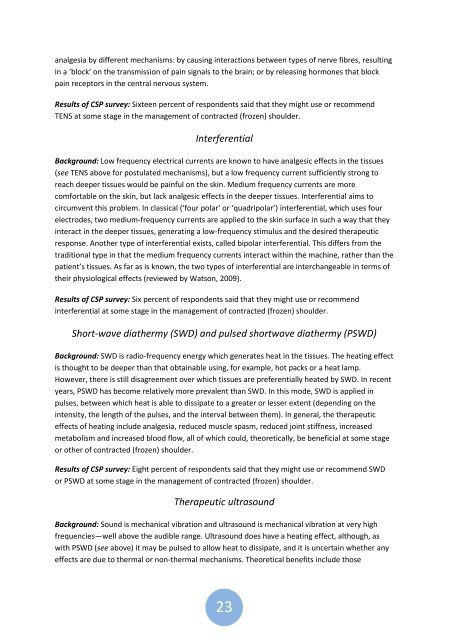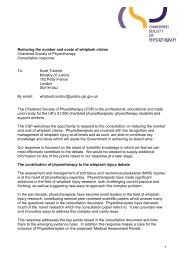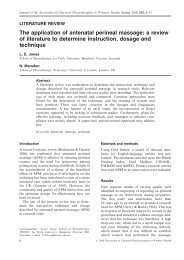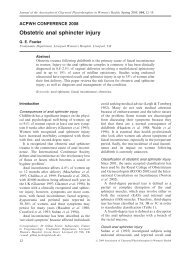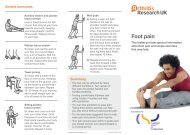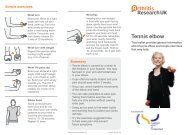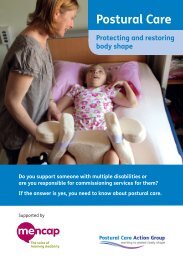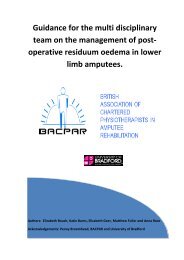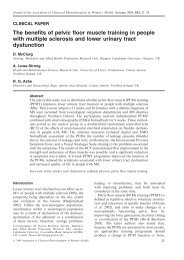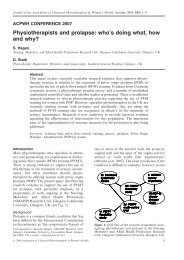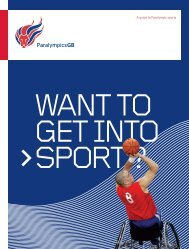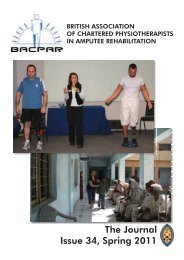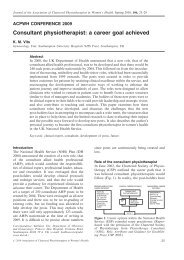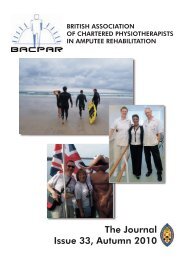here - The Chartered Society of Physiotherapy
here - The Chartered Society of Physiotherapy
here - The Chartered Society of Physiotherapy
Create successful ePaper yourself
Turn your PDF publications into a flip-book with our unique Google optimized e-Paper software.
analgesia by different mechanisms: by causing interactions between types <strong>of</strong> nerve fibres, resulting<br />
in a ‘block’ on the transmission <strong>of</strong> pain signals to the brain; or by releasing hormones that block<br />
pain receptors in the central nervous system.<br />
Results <strong>of</strong> CSP survey: Sixteen percent <strong>of</strong> respondents said that they might use or recommend<br />
TENS at some stage in the management <strong>of</strong> contracted (frozen) shoulder.<br />
Interferential<br />
Background: Low frequency electrical currents are known to have analgesic effects in the tissues<br />
(see TENS above for postulated mechanisms), but a low frequency current sufficiently strong to<br />
reach deeper tissues would be painful on the skin. Medium frequency currents are more<br />
comfortable on the skin, but lack analgesic effects in the deeper tissues. Interferential aims to<br />
circumvent this problem. In classical (‘four polar’ or ‘quadripolar’) interferential, which uses four<br />
electrodes, two medium-frequency currents are applied to the skin surface in such a way that they<br />
interact in the deeper tissues, generating a low-frequency stimulus and the desired therapeutic<br />
response. Another type <strong>of</strong> interferential exists, called bipolar interferential. This differs from the<br />
traditional type in that the medium frequency currents interact within the machine, rather than the<br />
patient’s tissues. As far as is known, the two types <strong>of</strong> interferential are interchangeable in terms <strong>of</strong><br />
their physiological effects (reviewed by Watson, 2009).<br />
Results <strong>of</strong> CSP survey: Six percent <strong>of</strong> respondents said that they might use or recommend<br />
interferential at some stage in the management <strong>of</strong> contracted (frozen) shoulder.<br />
Short-wave diathermy (SWD) and pulsed shortwave diathermy (PSWD)<br />
Background: SWD is radio-frequency energy which generates heat in the tissues. <strong>The</strong> heating effect<br />
is thought to be deeper than that obtainable using, for example, hot packs or a heat lamp.<br />
However, t<strong>here</strong> is still disagreement over which tissues are preferentially heated by SWD. In recent<br />
years, PSWD has become relatively more prevalent than SWD. In this mode, SWD is applied in<br />
pulses, between which heat is able to dissipate to a greater or lesser extent (depending on the<br />
intensity, the length <strong>of</strong> the pulses, and the interval between them). In general, the therapeutic<br />
effects <strong>of</strong> heating include analgesia, reduced muscle spasm, reduced joint stiffness, increased<br />
metabolism and increased blood flow, all <strong>of</strong> which could, theoretically, be beneficial at some stage<br />
or other <strong>of</strong> contracted (frozen) shoulder.<br />
Results <strong>of</strong> CSP survey: Eight percent <strong>of</strong> respondents said that they might use or recommend SWD<br />
or PSWD at some stage in the management <strong>of</strong> contracted (frozen) shoulder.<br />
<strong>The</strong>rapeutic ultrasound<br />
Background: Sound is mechanical vibration and ultrasound is mechanical vibration at very high<br />
frequencies—well above the audible range. Ultrasound does have a heating effect, although, as<br />
with PSWD (see above) it may be pulsed to allow heat to dissipate, and it is uncertain whether any<br />
effects are due to thermal or non-thermal mechanisms. <strong>The</strong>oretical benefits include those<br />
23


